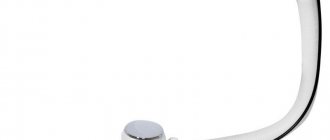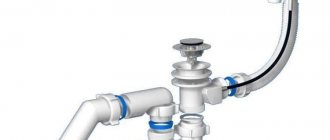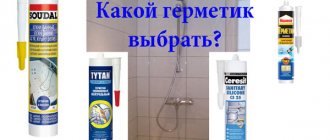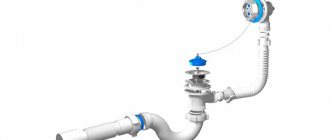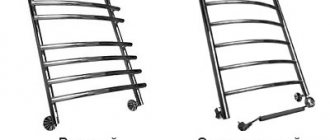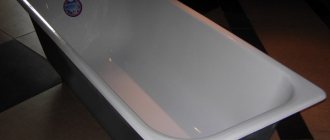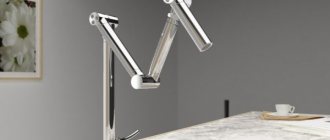Basic device
What do you need to start from to understand what kind of device this is? Everyone has known since Soviet times a siphon with a rubber stopper on a metal chain. This is what the basic model of the drain-overflow design looks like. Progress in the production of sanitary ware does not stand still. Today, even this design has undergone changes.
To drain the water, you no longer need to bend over and pull out the plug. The bathroom drain has become automated. There are a variety of device types available for sale. The drain-overflow system is often sold together with the bathtub. Masters advise choosing it yourself.
Tips and tricks for choosing material
To produce harnesses, manufacturers use several types of materials:
- plastic;
- non-ferrous metal – brass, bronze;
- black metal with nickel or chrome plating;
- stainless steel.
Plastic strappings are budget-friendly, last quite a long time, but are not particularly presentable.
The nickel-plated system looks better, is inexpensive and durable. It is installed on bathtubs covered with a decorative screen.
The most popular strappings are made of non-ferrous metal and stainless steel.
Brass, bronze and copper are especially aesthetically pleasing. They can be installed on a bathtub located in the center of the room. Copper is a soft metal with a reddish tint, brass is a yellow alloy, and bronze has a dark brown tint. Frames made from these materials look great in retro-style bathrooms.
Description of the drain-overflow mechanism
The function of the device is to drain liquid from the font into the sewer pipe. The entire system consists of interconnected hoses and tubes that are connected to two holes in the bowl and a sewer. The hole at the top on the wall of the bath prevents liquid from overflowing, the hole at the bottom is for draining liquid.
If the structure is installed correctly, then overfilling the tank is basically impossible. You can arrange it later if the speed at which the bowl fills with water is greater than it comes out.
Manual siphons
The simplest in design, known to anyone since Soviet times. They are a curved pipe system with a water seal and a drain. To shut off the water, a standard lid is used, most often attached to the overflow with a chain. To drain, it must be removed. The only advantage of classic siphons is that, if necessary, the lid can be easily replaced with a new one.
Classification of types of drain mechanism
Three types of devices are considered and each has its own design features.
Standard type device
This simplest design is represented by components:
- a siphon is represented by a pipe. It stops the penetration of unpleasant odors into the room;
- drain hole for overflow;
- liquid outlet hole at the bottom of the bowl;
- connecting tube for siphon and sewer pipe;
- The liquid is poured through a corrugated pipe into the siphon.
The mechanism is called traditional. When the drain neck is closed with a stopper, water is drawn into the tank.
Operational problems may arise with rubber gaskets. They change periodically. The price of a standard mechanism is 10-25 dollars.
It is classified as a reliable mechanism, since there are no moving elements in its design. The simple drain design is easy to assemble and install yourself.
Differences between automatic and semi-automatic mechanisms
Structurally, the drainage mechanism for the bathtub is designed in two types:
- automatic bath drain;
- semi-automatic in the bathroom.
Automatic bath drain
The device is also called “click-click”. The system works very simply. At the bottom of the bowl there is a button that starts the automatic siphon. The first press of the button opens the drain, the second press closes it. The operation of the mechanism depends on the spring that is attached to the system plug.
Automatic siphons
Able to regulate the filling of the bath without direct human intervention. When there is more water than needed, the system of such siphons automatically operates, opening the drain valve. This increases safety of use. To completely drain the water, you need to press the top of the lid with your hand or foot. Thanks to this principle of use, the system was called “click-clack”.
Installation of bath trim
Installation of the system begins only after the position of the bath is fixed. It is set according to level and height. This is especially true for products made of acrylic and metal, since they are unstable due to their light construction.
It is not recommended to completely cover the bathtub structure with facing material without an inspection hatch. It will provide quick access to the drain system in an emergency.
There are general recommendations for installing an automatic and semi-automatic bath overflow drain system:
- After installation, a distance of 15 cm is maintained between the base of the siphon and the floor covering.
- The tee hole is connected to the grille at the drain hole.
- A rubber gasket is installed at the time of connection.
- The siphon is connected to the outlet from the tee using a nut.
- The pipe is fixed on the side at the branch of the tee.
- The siphon is connected to the sewer.
- Each part of the device is sealed.
The work completed is checked. To do this, the tank is filled with water. A dry cloth is spread on the floor so that drops of water are visible if the system is not installed properly. A hole opens and the liquid flows down the drain system.
Features of a bath drain
Bathtub overflow
The drain-overflow is a structure consisting of a siphon and an overflow hole, which is connected by a tube. The siphon performs its standard function - it prevents unpleasant odors from the sewer from entering the room, and the overflow hole prevents the bath from overflowing and flooding.
The structure consists of the following parts:
- Drain neck - installed where the lower hole in the bathtub body is located. Structurally, there are two elements. They are pressed against the inner and outer surfaces; additional tightness is provided by rubber gaskets. The upper part – decorative – is made of chromed metal. The lower part is a pipe with a built-in nut. They are connected to each other using a metal screw.
- Overflow neck - from the side of the bathtub it is similar to the drain, but is installed where the top hole is located. When the water reaches the overflow hole, it begins to drain into the siphon. But the overflow is not able to completely protect against flooding, since the overflow pipe has a small diameter and with high pressure, the bath fills faster than the water drains.
- Siphon. There is a curved section that acts as a water seal. There is always water in it, blocking access to unpleasant odors from the sewer. Problems can arise due to errors in the design of the sewer system. In this case, the small volume water seal is broken by the vacuum formed in the system. Just in case, it is recommended to purchase a harness with a volume of about 400 ml.
- Connecting pipe. This is usually a corrugated hose that can be stretched or compressed, depending on the distance between the overflow and drain holes. The pipe attachment assembly can be crimped or not. In expensive models, sealing gaskets are additionally installed.
- Pipe for connection to the apartment sewerage system. It can be corrugated and hard. The first one is easier to connect, but the second one is more reliable in operation and more durable.
Additionally, the design is equipped with conical and flat sealing gaskets.
There are only 4 types of harness designs:
- traditional siphon with stopper;
- semi-automatic;
- machine;
- automatic machine with filling mode.
The traditional siphon has the simplest design, and therefore the lowest cost.
Classic: simplicity and reliability
Classic design
There are no moving parts or levers in a traditional drain and overflow. The main parts correspond to the design discussed above and are complemented by a stopper, which is attached to the overflow grill using a chain. She plugs the drain hole. Breakdowns are reduced to wear of the sealing gaskets.
Advantages:
- low cost;
- easy installation;
- reliability;
- resistance to breakage.
Flaws:
- fragility of sealing parts.
The assembly and installation of the classic bath frame is simplified as much as possible thanks to its simple design.
Semi-automatic design
Semi-automatic device
Behind the ease of use of the semi-automatic bathtub flush and overflow lies a complex system with a control lever. In addition to the main parts, the package includes a shut-off valve, which is controlled by a lever. The lever itself is:
- decorative handle;
- valve;
- button;
- swivel ring.
When the lever is pressed, the rod rises and the shut-off valve opens. When turned in the opposite direction, the rod lowers and the drain hole is sealed. The device operates by tensioning and loosening a cable, which can be installed inside or outside the overflow. The first option is more aesthetically pleasing, but more difficult to install.
Advantages:
- The overflow hole is not visible because it is masked by the control element.
- To seal the drain, you don't have to reach down to the bottom of the bathtub.
- Compactness.
- Varied design.
Flaws:
- high price;
- low reliability of the spring and shut-off valve;
- complex repair.
Thanks to the variety of design options, you can choose a semi-automatic drain for a bathroom with any design: high-tech, retro, modern. Characteristic style features are provided by shape, color, and materials.
Advantages of an automatic mechanism
Automatic mechanism
From an operational point of view, this system is the simplest. Control is carried out using a click-clack valve. No additional levers or plugs are required. It is convenient to press the valve with your heel while standing in the bath, thus sealing the hole. When pressed again, the valve opens.
Disadvantages of automatic bath drain:
- High price. The price of automatic devices can be several times higher than the cost of mechanical siphons.
- Breakdowns. Due to the complexity of the mechanism and insufficient quality materials, automatic systems quickly fail. Therefore, it is recommended to choose devices from well-known manufacturers.
- It is inconvenient to turn off the water. You have to bend over to manually press the valve.
If the spring that operates the valve fails, the entire structure will have to be replaced.
Automatic drain with water supply
The difference is that this system, unlike a conventional machine, is supplemented with pipes that supply water to the overflow hole. When the water reaches the hole, the filling stops automatically. These are expensive systems, the cost of which is several times higher than other designs. For example, the Grohe Talentofill model for standard bathtubs (28,990,000) costs more than 8 thousand rubles.
Manufacturers rating
- The automatic model of the Kaiser brand, produced in Germany, has won a leading position in the Russian market. The price of the structure is up to 3.0 thousand rubles.
- For buyers with average incomes, systems from the Viega and Geberit brands are offered. In terms of build quality, Geberit is inferior to Viega.
- Semi-automatic drain-overflow systems from the Abelone brand are in demand on the plumbing market. The automatic mechanism of this company can withstand 50 thousand operating cycles (the mechanism opens and closes). It is made of copper, various coatings are applied. Machine price: 3.2 – 3.5 thousand rubles.
- If you don’t want to spend money on bathtub drainage systems, then Frap brand models are ideal. The company produces budget and luxury devices. Their price: 1.0 – 3.0 thousand rubles.
- Easy to install Equation brand models. The company produces a system for both bathtubs and washbasins. Most models are made of plastic.
Materials used in manufacturing
Considering the rather fragile design of the semi-automatic bathroom siphon, it is necessary to correctly determine the material of manufacture. Depending on the manufacturer and model, the following applies:
- Plastic (polypropylene, polyvinyl chloride). It is durable and has a low cost, making plastic siphons the most popular. However, it is recommended to install such a device only on a bathtub equipped with a protective screen, since the appearance of the plastic is not aesthetically pleasing.
- Cast iron. It's heavy, weighs a lot and takes up a lot of space. Suitable for cast iron bathtubs only. Siphons made of this metal are demanding in terms of installation accuracy, which is why they have rarely been used recently.
- Any other metal (chrome steel, brass, bronze, etc.). It has a beautiful appearance, so the metal siphon can act as an additional element of decoration. Perfect for installation in an acrylic bathtub, especially if it is located in the middle of the room.
Copper-brass siphons are considered the best - they are resistant to corrosion and have high performance characteristics. However, such products are more expensive than all other analogues.
Before purchasing a semi-automatic bathtub siphon you like, it is advisable to obtain comprehensive information about the manufacturer and read reviews on the Internet. During operation, this product is constantly located in a rather aggressive environment, which means it must be reliable and durable. When choosing a plastic model, it must be thoroughly inspected to ensure there are no defects. Any chip or dent will have a negative impact on performance in the future.
Decorative siphon semi-automatic
You should be especially careful if the bathtub is custom-made. Standard equipment may not fit it, so it is necessary to measure the diameter of the drain holes and the distance to the overflow in advance.
And of course, you need to make sure that the product you are purchasing is not handicraft. The best way to avoid running into a fake is to go to a specialized store that has a good reputation. Even though the price there will be slightly higher, there will be more confidence in the quality of the products offered.
( 1 ratings, average: 5.00 out of 5)
Share:
What are they made from?
Drain and overflow systems are made from the following materials.
Plastic
Plumbing plastic is the cheapest material from which budget models are made. Plastic is not subject to corrosion, so the products have a long service life. But siphons and other plastic components do not have a very attractive appearance, so when carrying out modern renovations, plastic is most often used for hidden installation, for example, when the bathtub is covered with a screen.
Metal
Premium class overflow sinks are made of copper. Such drain sets have an attractive and sometimes original design, although this does not matter for hidden installation. Copper, brass and bronze are used to make drainage systems. Sometimes one drain and overflow system is made of different metals. For example, a siphon and pipes are made of brass, and tubes are made of bronze or copper.
In addition to their solid appearance, products made of non-ferrous metals have increased wear resistance and mechanical strength. But this does not give them any advantage over high-quality plastic products, since most likely you will make repairs much earlier than the plastic drain crumbles over time.
